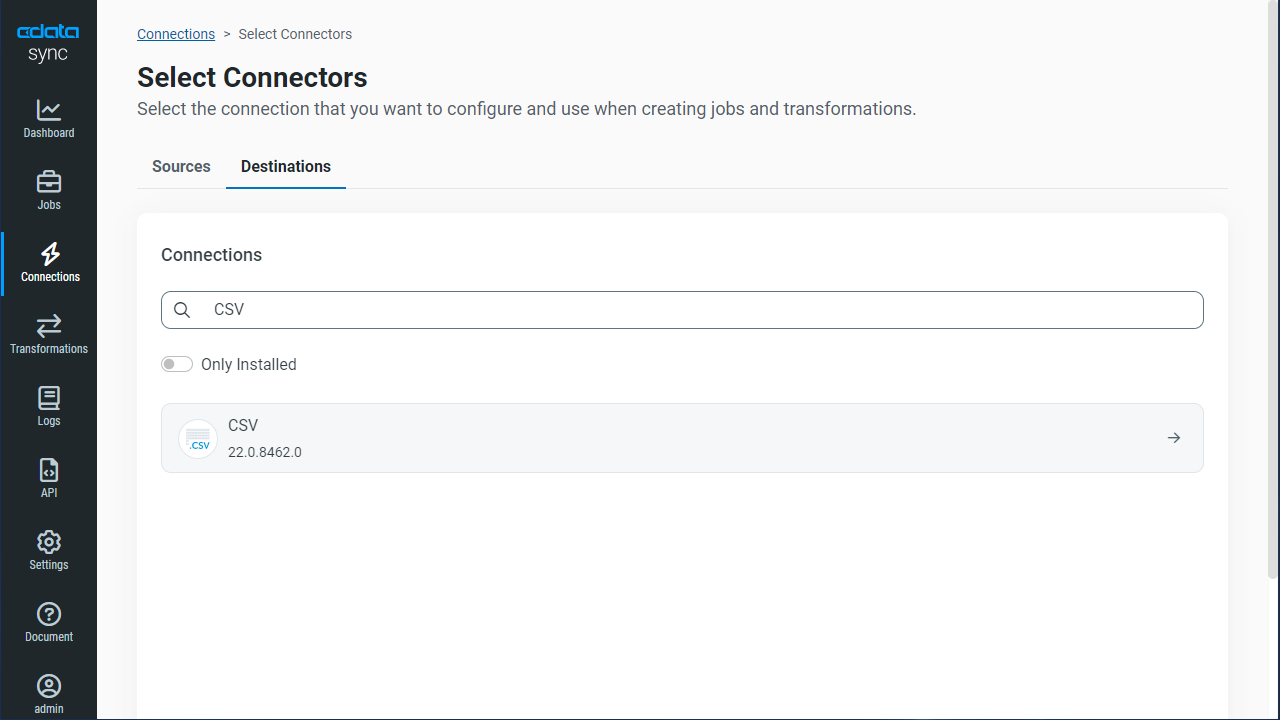Discover how a bimodal integration strategy can address the major data management challenges facing your organization today.
Get the Report →Automated Continuous Sage US Replication to Local Delimited Files
Use CData Sync for automated, continuous, customizable Sage US replication to delimited files (CSV/TSV).
Always-on applications rely on automatic failover capabilities and real-time data access. CData Sync integrates live Sage US data into local delimited files (CSV/TSV), allowing you to consolidate all of your data into a single location for archiving, reporting, analytics, machine learning, artificial intelligence and more.
Configure CSV/TSV as a Replication Destination
Using CData Sync, you can replicate Sage US data to delimited files, like CSV or TSV. To add a replication destination, navigate to the Connections tab.
- Click Add Connection.
- Select CSV as a destination.
![Configure a Destination connection to CSV.]()
- Enter the necessary connection properties. To connect to a directory for storing delimited files, set the following:
- Destination Folder: Set this location on the disk for the delimited files.
- Include Column Headers: Set this to True for the first row in each file to represent the column names.
- Click Test Connection to ensure that the connection is configured properly.
![Configure a Destination connection.]()
- Click Save Changes.
Configure the Sage US Connection
You can configure a connection to Sage US from the Connections tab. To add a connection to your Sage US account, navigate to the Connections tab.
- Click Add Connection.
- Select a source (Sage US).
- Configure the connection properties.
The Application Id and Company Name connection string options are required to connect to Sage as a data source. You can obtain an Application Id by contacting Sage directly to request access to the Sage 50 SDK.
Sage must be installed on the machine. The Sage.Peachtree.API.dll and Sage.Peachtree.API.Resolver.dll assemblies are required. These assemblies are installed with Sage in C:/Program Files/Sage/Peachtree/API/. Additionally, the Sage SDK requires .NET Framework 4.0 and is only compatible with 32-bit applications. To use the Sage SDK in Visual Studio, set the Platform Target property to "x86" in Project -> Properties -> Build.
You must authorize the application to access company data: To authorize your application to access Sage, restart the Sage application, open the company you want to access, and connect with your application. You will then be prompted to set access permissions for the application in the resulting dialog.
While the compiled executable will require authorization only once, during development you may need to follow this process to reauthorize a new build. To avoid restarting the Sage application when developing with Visual Studio, click Build -> Configuration Manager and uncheck "Build" for your project.
![Configure a Source connection (Salesforce is shown).]()
- Click Connect to ensure that the connection is configured properly.
- Click Save Changes.
Configure Replication Queries
CData Sync enables you to control replication with a point-and-click interface and with SQL queries. For each replication you wish to configure, navigate to the Jobs tab and click Add Job. Select the Source and Destination for your replication.

Replicate Entire Tables
To replicate an entire table, click Add Tables in the Tables section, choose the table(s) you wish to replicate, and click Add Selected Tables.

Customize Your Replication
You can use the Columns and Query tabs of a task to customize your replication. The Columns tab allows you to specify which columns to replicate, rename the columns at the destination, and even perform operations on the source data before replicating. The Query tab allows you to add filters, grouping, and sorting to the replication.
Schedule Your Replication
In the Schedule section, you can schedule a job to run automatically, configuring the job to run after specified intervals ranging from once every 10 minutes to once every month.

Once you have configured the replication job, click Save Changes. You can configure any number of jobs to manage the replication of your Sage US data to delimited files.










